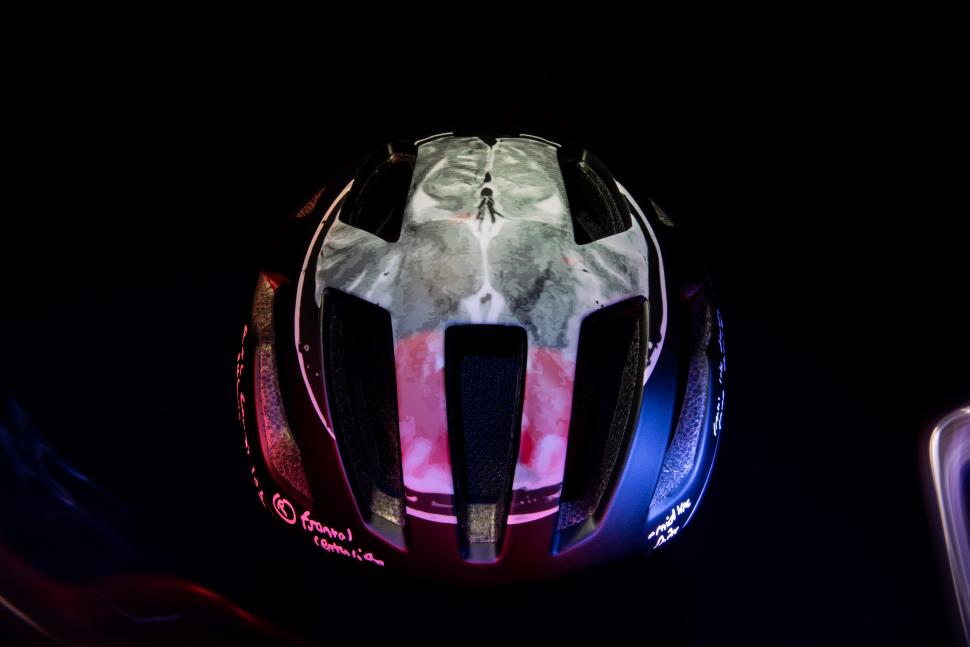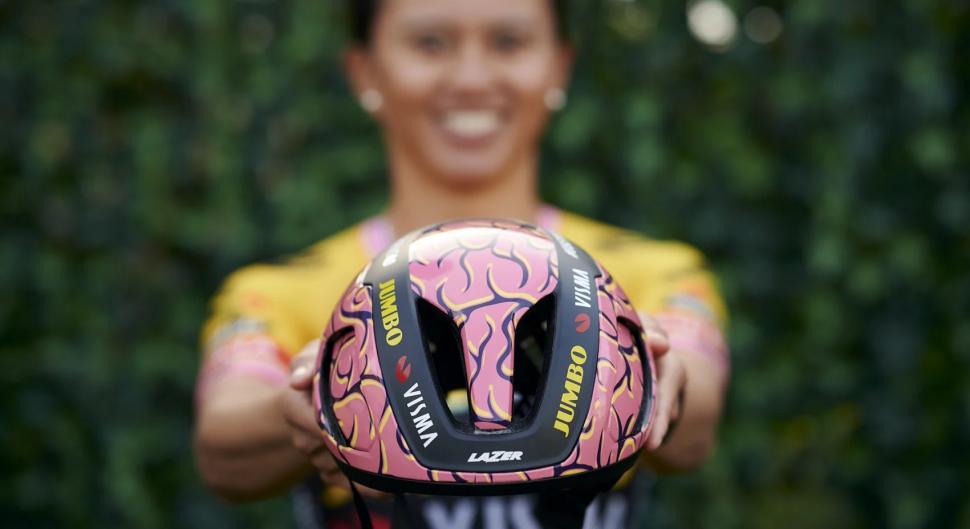- News
- Reviews
- Bikes
- Accessories
- Accessories - misc
- Computer mounts
- Bags
- Bar ends
- Bike bags & cases
- Bottle cages
- Bottles
- Cameras
- Car racks
- Child seats
- Computers
- Glasses
- GPS units
- Helmets
- Lights - front
- Lights - rear
- Lights - sets
- Locks
- Mirrors
- Mudguards
- Racks
- Pumps & CO2 inflators
- Puncture kits
- Reflectives
- Smart watches
- Stands and racks
- Trailers
- Clothing
- Components
- Bar tape & grips
- Bottom brackets
- Brake & gear cables
- Brake & STI levers
- Brake pads & spares
- Brakes
- Cassettes & freewheels
- Chains
- Chainsets & chainrings
- Derailleurs - front
- Derailleurs - rear
- Forks
- Gear levers & shifters
- Groupsets
- Handlebars & extensions
- Headsets
- Hubs
- Inner tubes
- Pedals
- Quick releases & skewers
- Saddles
- Seatposts
- Stems
- Wheels
- Tyres
- Health, fitness and nutrition
- Tools and workshop
- Miscellaneous
- Tubeless valves
- Buyers Guides
- Features
- Forum
- Recommends
- Podcast
news
 White cycle helmet
White cycle helmetHelmet market to grow by over $300 million globally in the next four years
The global bike helmet market is expected to grow by $325 million between 2022 and 2027, with 30 per cent of the rise coming from Europe, and aided by factors such as pro-cycling government initiatives, increase in road cycling accidents, and increasing demand for customised helmets.
A new report by market research company Technavio predicts that the helmet market, on an average, will accelerate on a compound annual rate of 5.9 per cent each year at least for the next four years, resulting in a massive market size increase of $325 million.
The most notable driving factor of this growth, according to Technavio, is the rise in government initiatives promoting cycling, with the European Union having made integrating cycling into its multimodal transport policy a top priority, and even the US encouraging cycling to reduce traffic congestion in its cities.
Another interesting market driver is the increasing demand for customised cycling helmets, particularly by corporate users, associations, and clubs. While already growing in popularity in Europe and Americas, customised products are also becoming popular in places like China and India.
The company studied the market growth of three helmet categories: road, sports, and MTBs, and found that road helmets are likely to occupy almost half the market share, as more and more people use bikes for daily commutes. The report also said the high living standards of those cycling, especially in the UK, France and Italy, drew them to novel products and premium brands’ goods.
However, the report pointed out a concerning trend — that the demand could also be fuelled by the rise in road injuries in recent years.
Recently, a number of helmet brands have tried to raise awareness among all cyclists to wear helmets. During the Brain Awareness Week in March, Endura launched “world's most graphic cycle helmets” featuring CAT scans of cyclists' brain injuries to encourage helmet wearing.
One of the helmets featured the scan of Ian Charlesworth, 62, who was struck by the driver of an HGV in 2019, while another featured John Moroney's, a cyclist injured in a collision with the driver of a 4x4 in Bristol.
Members of Team Jumbo Visma wore unique “brain design” helmets at this weekend’s action-packed monument Paris-Roubaix. The Dutch team, whose member Wout Van Aert finished third after suffering an unfortunate puncture at the cobbled classic’s later stages, collaborated with its Belgian helmet supplier Lazer for this initiative.
> Mathieu van der Poel wins fastest ever Paris-Roubaix after Wout van Aert puncture drama
Helmet safety is probably a passionately contentious issue for a lot of cyclists, with people being divided on whether helmets are really a necessity for safe cycling.
Although studies from University of New South Wales and Norway's Institute of Transport Economics show helmets can significantly reduce the odds of head injury, experts such as psychologist Dr Ian Walker believes not wearing one can reduce the probability of a collision, with Olympian and active-travel advocate Chris Boardman himself calling the helmet issue a “massive red herring”.
However, another reason for a higher demand for helmets could also be the enforcement of wearing helmets for cyclists. From this month, a new law came into force in Japan that made helmets compulsory for all cyclists, making it the fifth country along with Argentina, Australia, Cyprus and New Zealand to have national mandatory cycle helmet laws applying to all cyclists.
The report from Technavio perhaps comes as a surprise, as we’ve seen the boom in the cycling industry due to the COVID-19 pandemic slow down, with the growth of public interest in cycling resuming back to normal.
> "Drastic slowdown" in demand sees MIPS' net sales slump 46% in final quarter of 2022
Since the end of last year, a number of cycling retailers have suffered a reduction in demand, with Halfords, the UK’s biggest retailer of bicycles, reporting that the domestic cycling market had contracted by 20 per cent over the past year.
The Swedish company MIPS, which is behind the prominent helmet safety system, also suffered a “drastic slowdown” in demand as its net sales slumped by 46 per cent in the final quarter of 2022.
In February, the Bicycle Association observed the sales slowdown since the Covid bike boom in its annual report, with sales of bikes in the UK dropping to the lowest level in two decades.
The new Technavio report, which involved “detailed analyses of the competitive landscape of the market and information about 15 market vendors”, including Halfords, Kask and Mavic, amongst others, said that the rising prices of raw materials could be a challenge to the market growth.
Adwitiya joined road.cc in 2023 as a news writer after graduating with a masters in journalism from Cardiff University. His dissertation focused on active travel, which soon threw him into the deep end of covering everything related to the two-wheeled tool, and now cycling is as big a part of his life as guitars and football. He has previously covered local and national politics for Voice Wales, and also likes to writes about science, tech and the environment, if he can find the time. Living right next to the Taff trail in the Welsh capital, you can find him trying to tackle the brutal climbs in the valleys.
Latest Comments
- Laz 1 hour 3 min ago
hopefully, that will be the last time we see that van in drivable condition
- Nick T 2 hours 19 min ago
Come again chief? The Tarmac in size 56 has a 73.5 degree HTA, the Addict in the same size comes in at 73.4 degrees. In terms of bike fit that's...
- TheBillder 4 hours 1 min ago
My new double glazed wooden framed sash windows are £1600 plus vat per (quite large) window. House built in 1904. The cost includes fitting and...
- galibiervelo 4 hours 17 min ago
We promote #bikefriday You dont need it - go for a spin. Nice bikes and kit are lovely, but not as noice as a dawn spin this friday morning with a...
- David9694 4 hours 20 min ago
Council acting like ‘the Sheriff of Nottingham’ with parking charges...
- David9694 4 hours 24 min ago
Man taken to hospital after vehicle crashes into pub...
- David9694 4 hours 34 min ago
Car flips in Millennium Way, Sheerness, near former Aldi supermarket that reopens as Home Bargains this weekend...
- RoubaixCube 5 hours 3 min ago
Ive been using the same £2-3 dish brush I bought from wilko, tesco or pound land for as long as I can remember. I dont understand why anyone would...
- S.E. 6 hours 39 min ago
I'm thinking CX tyres...


Add new comment
31 comments
.
Pages